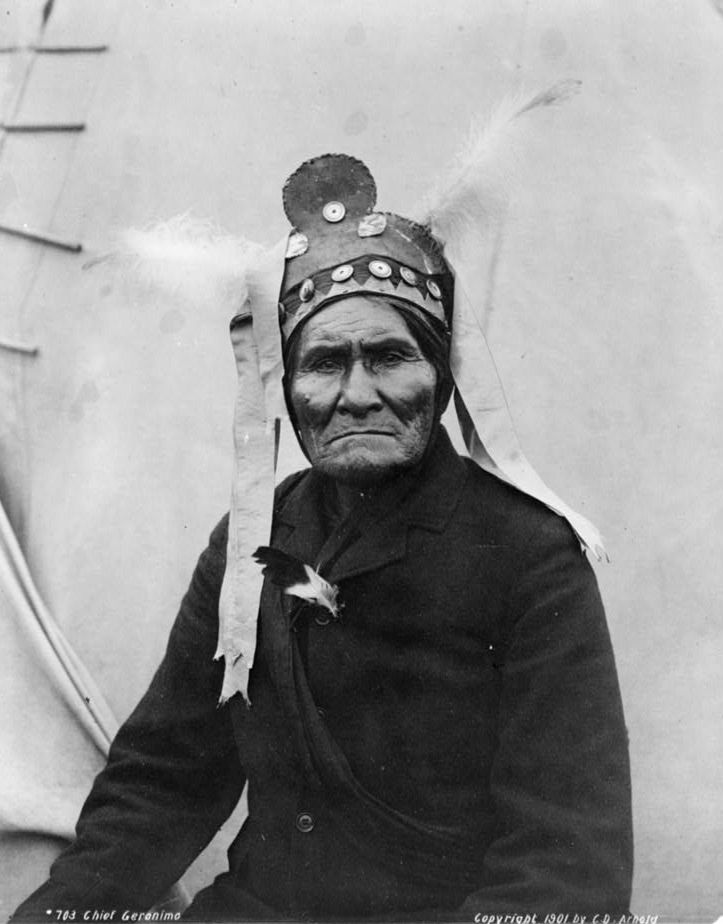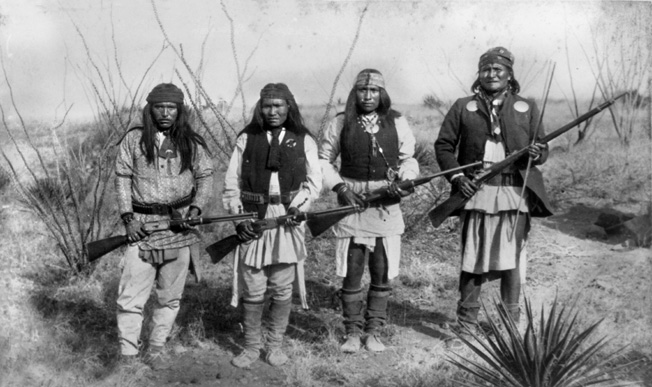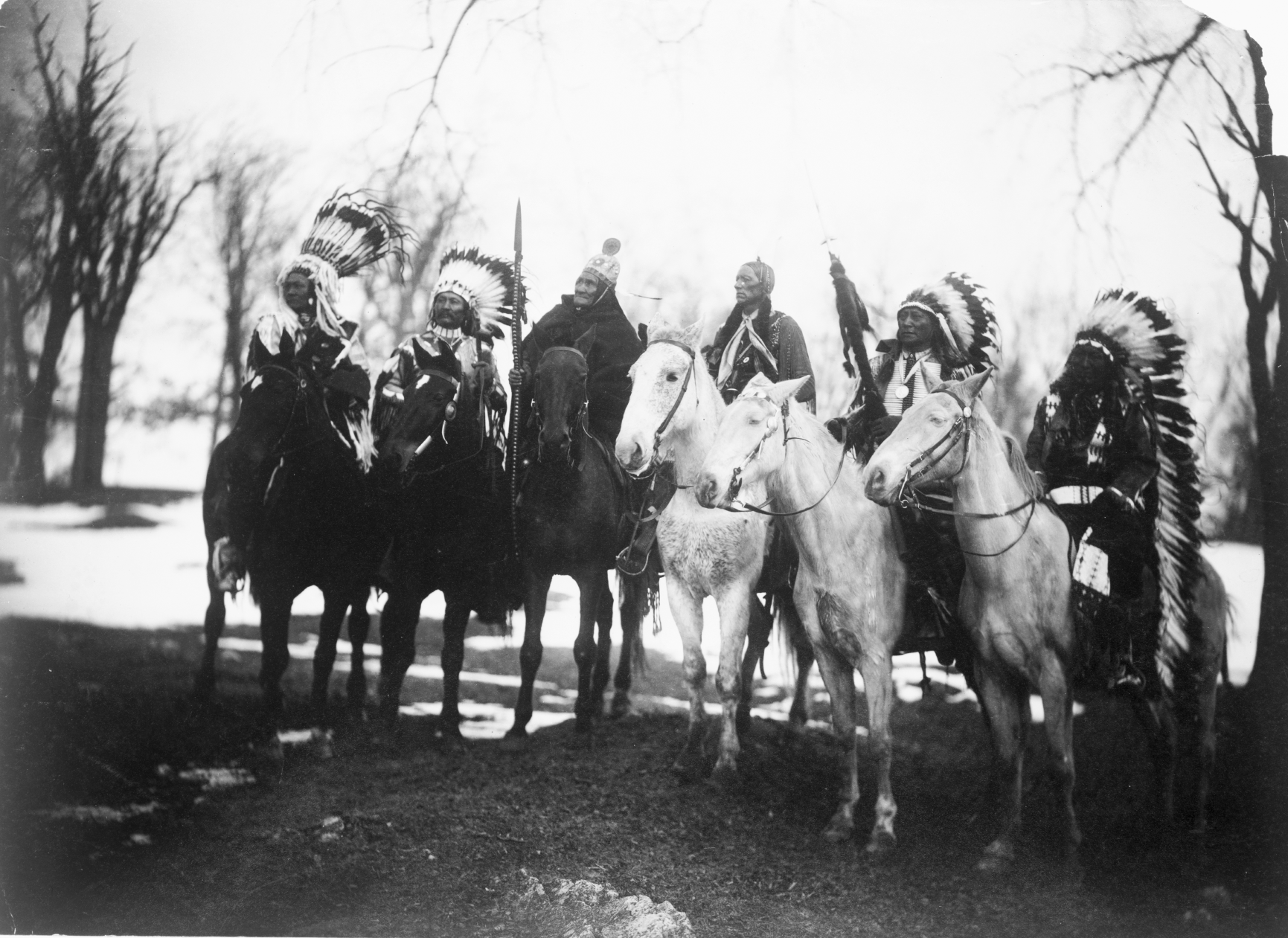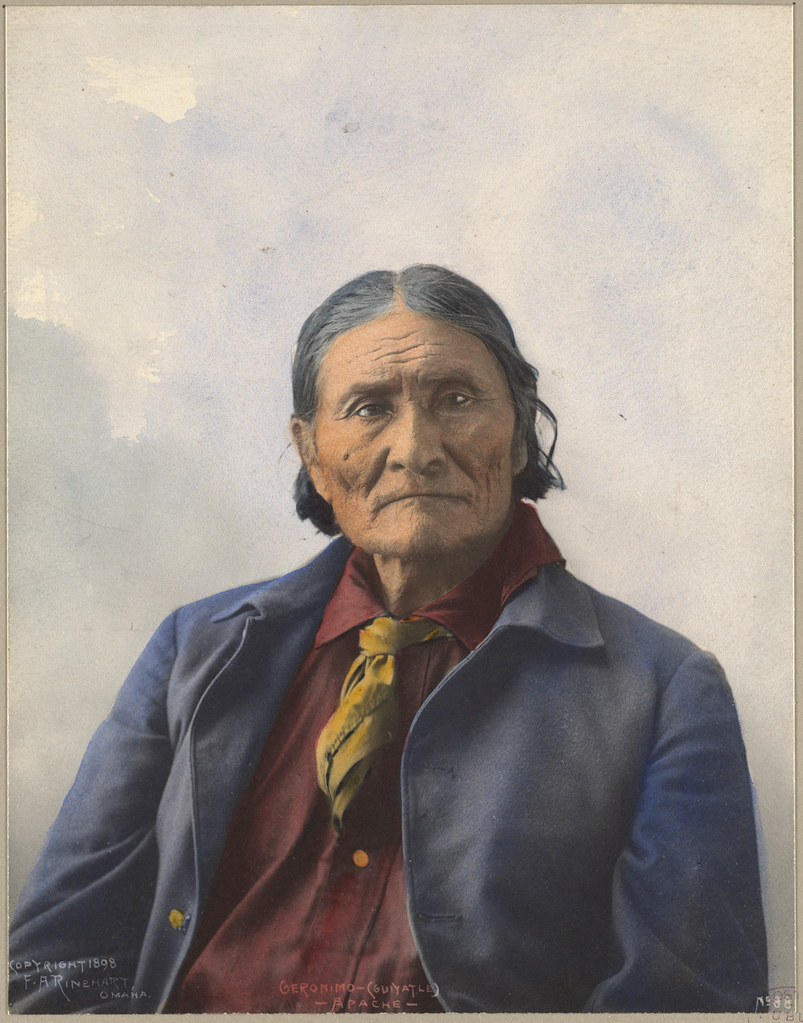.

Chiricahua Apache Chief Geronimo at Pan-American Exposition, Buffalo, New York: photo by Charles G. Dudley, 1901 (Library of Congress)
We call his mother Juana
She had him near Tulerosa
Rocket Country still
Notorious through his opposition
To Alien authority
And by Systematic
And Sensational advertising
His Pleasures were widely known
As Depredations
Among the Invader
Eyes like two bits of obsidian
With a light behind them
Edward Dorn: from Recollections of Gran Apacheria, 1974

Scene in Geronimo's camp, before surrender to General Crook, 27 March 1886: Geronimo and Natches mounted, Geronimo's son, Perico, standing at his side holding baby: photo by A.S. Fly, 1886 (Library of Congress)
Osama Bin Laden: Why Geronimo?
Kathryn Westcott, BBC News, 3 May 2011
The code name for the operation to capture Osama Bin Laden is thought to have been Geronimo. Why was it named after one of the best-known Native Americans?
Geronimo. The Apache warrior's name conjures up an image of the American Wild West, the world over.
In the best-known photograph of him -- taken in 1887 -- he glares defiantly into the camera, gripping a rifle. It was this fearless warrior that led the last band of Apache resistance to the white Americans.
The fact that Bin Laden had been killed by US special forces was reported to President Barack Obama on Sunday with the words "Geronimo EKIA" -- Enemy Killed In Action.
But US officials have refused to comment on whether this was Bin Laden's code name, or the code name of the operation, or why the name Geronimo was chosen -- and may never do so.
It was back in 2001 that the narrative for America's hunt for the al-Qaeda leader became strewn with Wild West imagery.
George W Bush's call for Bin Laden to be caught "dead or alive" mimicked the posters of the old Hollywood westerns, while borderland Pakistan became the Old West reincarnated in the minds of many commentators.
Bin Laden was referred to by one as a "21st-Century Geronimo, trying to elude the US military somewhere in a dry mountain range that could easily pass for the American West".
Afghanistan's cave-laced mountains, were easy to imagine using the template of the Sierra Madre mountain range thousands of miles away, where the original Geronimo managed to elude US troops for so long in the late 19th Century.
Referring to US military possibilities in the tribal areas of Afghanistan's mountainous regions, Allan R Millet, a retired Marine Corps colonel and Ohio State University professor, said in 2001: "It's like shooting missiles at Geronimo... you might get a couple of Apaches, but what difference does that make?"
Geronimo
Geronimo was actually given the name Goyahkla at birth. One theory is that he acquired the name Geronimo from the Mexicans he fought to avenge the death of members of his family.
According to one story the Mexicans would shout: "Cuidado! (Watch out!) Geronimo!". It could be because they mispronounced his name or, as some historians have suggested, they were calling for the protection of St Jerome.
The real Geronimo was born in 1829 in what is modern day New Mexico. As one of the Apache leaders, he inherited a tradition of resisting colonisation by both Spaniards and North Americans.
According to Ron Jackson writing in The Oklahoman newspaper in 2009, Geronimo's "legend is rooted in real deeds of bravery and bloodshed."
He gained early notoriety for his fearless raids against Mexican soldiers. Mexican troops had killed members of his family after storming his village, and his revenge was to kill as many of them as possible.
"By 1872, US government officials were keenly aware of Geronimo's fighting exploits when they corralled him and hundreds of his fellow Chiricahua Apache people onto an Arizona Territory reservation," writes Mr Jackson.
"Four years later, Geronimo led a large band of Apache dissidents off the reservation and into the Sierra Madre mountains of Old Mexico, where they staged raids on anyone unlucky enough to cross their paths.
"Military officials soon branded Geronimo a renegade. During the next decade, Geronimo repeatedly returned to reservation life in peace only to bolt with others for the refuge of the Sierra Madres. They often left a trail of blood. Hidden in the myriad mountain passes and caves, Geronimo and his followers embarrassed military officers by eluding them time and again, at one point with as many as 5,000 US soldiers on their heels."
It was Apache scouts that helped track Geronimo down in 1886. As a prisoner of war he became a celebrity, dictating his memoirs and taking part in President Theodore Roosevelt's inaugural parade in 1905. He died of pneumonia at Fort Sill in Oklahoma in 1909, after falling from his horse.
His struggle to resist the white Americans has led to him being depicted in a sympathetic light by many cultural historians.
Ironically, it is thanks to the Native American's legendary bravery that two of the US army's elite units have the regimental nickname "Geronimo".
The link to the parachute divisions' monikers and the tradition of shouting "Geronimo" while bailing out of a plane can be traced to Fort Benning in the state of Georgia.
According to reports, in 1940 soldiers from the parachute division were preparing to test a daring new manoeuvre, in which men jumped from the plane in rapid succession.
The night before the jump, a small group of soldiers left the base to watch film at the local cinema -- a western featuring the fearless Geronimo. As the men later revealed their apprehension about the next day's jump, Pt Aubrey Eberhardt announced that he was going to shout "Geronimo" as he leapt from the plane to demonstrate his courage.
The story goes that as he jumped, "G-E-R-O-N-I-M-O" was clearly heard from the ground. The motivational yell was adopted other servicemen and quickly became standard practice for US army paratroopers -- and the favoured cry for little boys performing a daring leap.
The word "Geronimo" was eventually discontinued by the army in favour of a parachute opening count -- "one-thousand, two-thousand" -- but by this stage it was already the name of the the army's first parachute battalion, the 501st Parachute Infantry Battalion.
The nickname Geronimo has also adopted by the 1st Battalion (Airborne), 509th Infantry Regiment, which has been operational in Iraq and Afghanistan. By adopting the tactics and techniques of al-Qaeda and the Taleban, they help to train other units to defend themselves.
The original Geronimo is buried at Fort Sill -- but one branch of his descendants argue that he should be laid to rest in his tribal homeland of the Gila Mountains of New Mexico. Until the correct sacred burial rite is carried out there, they say, his spirit is still wandering.

Geronimo, head chief of the Chiricahua Apaches, identified in 1887 newspaper photo caption as "now on the war path in Sierra Madres": here seen in studio portrait, holding a rifle and wearing boot moccasins, a breechcloth, and scarves around his neck. (From photographer's notes: "Genuine age 50 to 55. Rather polite fellow, thought cunning, far seeing. Perfect photo for newspaper in every respect. Three squaws -- most cow cunning on reservation, small squint eyes = looked sideways, spoke Spanish): photo by A.T. Willcox, July 1885 (U.S. Department of Defense/Department of the Army/Office of the Chief Signal Office/National Archive)
Bin Laden killed: Geronimo code name angers Apaches
BBC News, 4 May 2011

Geronimo, pictured in 1887, fought to protect his land, his people and their way of life
An Apache tribe in the US has demanded an apology from President Obama for using the name of the warrior Geronimo as the code name for Osama Bin Laden.
Jeff Houser, Fort Sill Apache Tribal Chairman, said equating the legendary Apache to a mass murderer was painful and offensive to all Native Americans.
The commando team that attacked and killed the al-Qaeda leader used the name in its progress reports. The US Defence Department said no disrespect had been intended.
It would not elaborate on the use of the name Geronimo, but said its code names were usually chosen at random.
Code names allow soldiers taking part in missions to communicate with each other without divulging vital information to eavesdroppers.
In his letter to Mr Obama -- also posted on the Oklahoma tribe's website -- Mr Houser said: "Right now Native American children all over this country are facing the reality of having one of their most revered figures being connected to a terrorist and murderer of thousands of innocent Americans.
"Think about how they feel at this point."

Chiricahua Apache chief Geronimo (right) and a small group of his warriors: photographer unknown, 1886 (Arizona Historical Society)
Apache Chairman Seeks Apology for Geronimo Slur
by Jeff Houser, Apache Tribal Chairman, via Fort Sill Apache, 3 May 2011
FOR IMMEDIATE RELEASE
APACHE, Oklahoma (May 3, 2011) - The Chairman of the Fort Sill Apache Tribe has asked President Obama to issue a formal apology for the United State’s recent association of the name of Geronimo with Osama Bin Laden.
"We are grateful that the United States was successful in its mission against Bin Laden, but associating Geronimo's name with an international terrorist only perpetuates old stereotypes about Apaches.” said Jeff Houser, Chairman of the Fort Sill Apache Tribe, the successor to Geronimo’s Chiricahua Apache Tribe. “In the 1800's Geronimo and the Chiricahua Apache people were portrayed as savages. This portrayal was used as justification for the forced removal from their homelands and their subsequent imprisonment. Linking Geronimo’s name to an infamous terrorist only reinforces this false and defamatory stereotype.”
The letter, which was faxed to the White House on May 3, 2011, emphasizes the Apache leader’s status as a Native American icon, recalls the United States House of Representatives February 2009 Resolution honoring him, and makes a personal appeal to the President to “right this wrong.”
The Fort Sill Apache Tribe is successor in interest to the Chiricahua and Warm Springs Apache people that lived in Southern New Mexico and Arizona until 1886, when they were forcibly removed and held as Prisoners of War of the United States for 28 years. The Tribe’s members are descendants of those people who upon their release in 1914 remained in Oklahoma and maintained their status as independent Chiricahua and Warm Springs Apaches until the tribe was restored years later as the Fort Sill Apache Tribe. The tribe has long expressed its desire to return to its homelands.

Six tribal leaders: (left to right) Little Plume (Piegan), Buckskin Charley (Ute), Geronimo (Chiricahua Apache), Quanah Parker (Comanche), Hollow Horn Bear (Brulé Sioux), and American Horse (Oglala Sioux) on horseback in ceremonial attire: photo by Edward S. Curtis (1868-1952), c. 1900 (Library of Congress)

Indian chiefs, headed by Geronimo, passing in review before president Theodore Roosevelt at his inauguration, Washington, 4 March 1905: photo by Keystone View Company, 1905 (Library of Congress)

Geronimo (Goyaalé,"one who yawns", born Gila River Arizona, 16 June 1829, died Fort Sill, Oklahoma, 17 February 1909): "This portrait of the historical old Apache was made in March, 1905. According to Geronimo's calculation he was at the time seventy-six years of age, thus making the year of his birth 1829. The picture was taken at Carlisle, Pennsylvania, the day before the inauguration of President Roosevelt, Geronimo being one of the warriors who took part in the inaugural parade at Washington. He appreciated the honor of being one of those chosen for this occasion, and the catching of his features while the old warrior was in a retrospective mood was most fortunate": description and photo by Edward S. Curtis (1868-1952), from Curtis: The Apache, the Jicarillas, the Navaho, 1907 (Northwestern University Library/Library of Congress)

Chief Geronimo, Apache leader, holding bow and arrows: photographer unknown, c. 1904 (Library of Congress)

Geronimo (Guiyatle), Apache: photo by Frank A. Rinehart, 1898 (Boston Public Library)